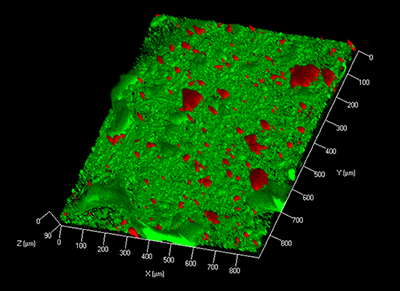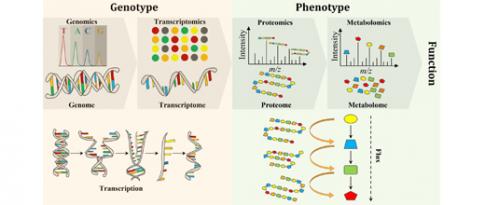Thesis prepared by Maxime Carrié: "Study and modeling of biofilm IBE fermentation"
The market for biobased alcohol is currently largely focused on the production of ethanol for use in biofuels. C3 and C4 alcohols are platform molecules for biobased chemistry, but their development is hampered by low productivity levels due to the limited tolerance of microorganisms to these metabolites.
One strategy to increase these productivity levels consisted in developing a continuous production method combined with a biomass retention system within the reactor. Its principle, patented by IFPEN [1], hinged around exploiting the natural capacity of the microorganism to grow in the form of a productive microfilm. The latter immobilizes the bacterial cells, thereby increasing the residence time and concentration of bacteria in the reactor, resulting in a volume productivity multiplied by 4. However, this atypical and innovative approach creates many challenges in terms of understanding its scale-up, particularly since productive biofilms have received little coverage in the literature.
The thesis research related to the characterization of this type of biofilm via new approaches using flow cytometrya [2] and confocal microscopyb (Figure). Using these methodologies, the evolution of the viability of the biofilm formed over time was described. In parallel, a temporal metabolite production model was developed. This makes it possible to describe continuous immobilized fermentation via a set of 15 equations. Moreover, by creating and exploiting an experimental database of immobilized fermentation, it was possible to identify the key parameters for the model, which was then implemented in a numerical tool.

produced by confocal laser scanning microscopy (x100)
This numerical tool [3] accurately describes the phenomena at play (biofilm growth, molecule productionc). It describes cell detachment and attachment phenomena, in the bioreactors, as well as the ramp-up and associated volume productivity.
This research has led to a significant improvement in knowledge of biofilm formation and paves the way for a better understanding of the immobilized process. In turn, this will lead to improved process control and , both in terms of reproducibility and optimization of volume productivity.
a- individual, quantitative and qualitative characterization technique for particles suspended in a liquid.
b- making it possible to produce images with a very shallow field depth.
c- isopropanol-butanol-ethanol.
Bibliographic references:
-
Carrié, M.; Velly, H.; Ben-Chaabane, F.; Gabelle, J.-C. (2022)"Method for carrying out a process for alcohol production via fermentation", Patent pending, FR21 11141.
-
Carrié, M.; Gabelle, J.-C.; Ben-Chaabane, F.; Velly, H. (2022) "Enzymatic breakdown of biofilm matrix to allow flow cytometry viability analysis of Clostridium beijerinckii cells". In : Journal of Applied Microbiology. Accepted .
-
Carrié, M.; Velly, H.; Ben-Chaabane, F.; Gabelle, J.-C. (2022) "Modeling fixed bed bioreactors for isopropanol and butanol production using Clostridium beijerinckii DSM 6423 immobilized on polyurethane foams". In : Biochemical Engineering Journal, vol. 180.
>> https://doi.org/10.1016/j.bej.2022.108355
Scientific contacts: jean-christophe.gabelle@ifpen.fr ; helene.velly@ifpen.fr
You may also be interested in
The “Omics”, seven hired hands working for biotechnology
Most frequently, the use of a microorganism in the production of biofuels or biosourced chemicals requires its optimisation. This is achieved through genetic engineering, which involves inactivation and/or addition of one or more genes, to improve the ability of this microorganism to produce a target molecule. (...) At IFPEN, access to genomics (DNA) has helped in gathering data on the composition and structure of the genomes of the microorganisms...






